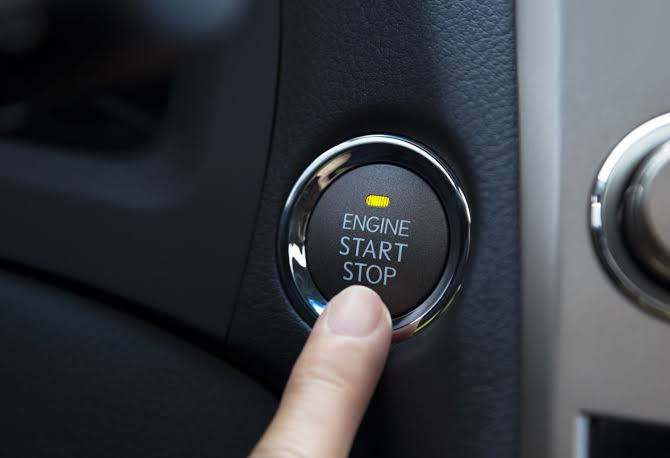In modern vehicles, the traditional key-style ignition switch has been largely replaced by the Start Engine Push Button system. This advanced system uses a Smart Fob to send a coded security signal to the Powertrain Control Module (PCM) via the vehicle’s keyless entry system when the fob is inside the vehicle. This signal informs the PCM that the engine can be started.
However, before the engine will start, the transmission must be in Park or Neutral, and the driver must depress and hold the brake pedal. Pressing the Start Engine Button sends a command to the PCM, which then checks the status of the Park/Neutral Safety switch and the Brake Pedal Switch. If the transmission is in Park or Neutral, and the brake is on, the PCM sends a start command to the starter motor to crank the engine.
Common Issues and Solutions When the Engine Does Not Start
If the engine does not crank when you press the Start Engine button, several potential issues could be preventing the engine from starting. Here are the most common problems and their solutions:
Dead Battery Inside Smart Key Fob
A dead battery in the Smart Key Fob can prevent the engine from starting. To resolve this, hold the dead key fob against the start button, then use the fob to press the Start Engine button down.
This should allow the button to inductively read the security code in the fob and pass the start command to the PCM, allowing the engine to start. Replace the dead battery inside the Smart Fob with a new one as soon as possible to avoid future issues.
Wrong Key Fob or Defective Key Fob
If you accidentally picked up the wrong key fob for your vehicle, or if the fob itself is defective, your engine will not start.
In this case, have your vehicle towed to your car dealer to have a new fob programmed for your vehicle, or call a certified locksmith who can replace and program a new key fob.
Defective Start Engine Button
If you have the correct key fob and the battery inside the fob is good, but nothing happens when you press the Start Engine Button or use the fob to press the Start Button, the Start Engine Button itself may be defective. Replace the defective Start Engine Button with a new one to resolve this issue.
Car Battery is Dead
A dead or discharged car battery can prevent your engine from cranking or starting. Open the hood and check the battery voltage with a voltmeter. A battery that has more than about 12.4 volts should have enough voltage to start your engine. If the battery is low or dead, try jump-starting the battery from another vehicle, or hook up a battery charger to recharge or boost the battery. Also, check the battery cable connections to ensure they are clean and tight. Have your battery tested to determine its condition. If it is more than 4 or 5 years old, you may need a new battery.
PCM Problem
If the PCM has an internal fault, or if there is a problem with the anti-theft system (such as not reading the fob correctly or the security codes have gotten out of sync), further diagnosis will be necessary to determine the problem. This type of diagnosis is beyond the skill level of most do-it-yourselfers and requires a professional-grade scan tool with bi-directional and reprogramming capability.
Read Also: How To Deactivate the Immobilizer From Your ECU (Complete Guide) Unlocking the Secret
Bad Starter
If the starter motor, or the relay, module, or solenoid that energizes the starter is bad, the starter will not crank the engine. Try jumping the starter directly to see if it cranks the engine. This will tell you if the starter is working. The starter can also be removed and taken to an auto parts store that has a starter tester.
If the starter tests bad, you need a new starter. If it tests good, the problem is likely a bad starter module, relay, or solenoid. Be sure to inspect all the cables and wires that connect to the starter. Loose, corroded, or damaged wire connections can prevent a good starter from cranking. So can a low battery. Additionally, a damaged starter drive gear or missing or broken teeth on the engine’s flywheel may prevent the starter from cranking the engine.
Blown Fuse
Locate the Power Center under the hood and check for blown fuses in the starter circuit. Replace any blown fuses as needed, always using the same amp capacity fuse.
Engine Cranks But Will Not Start
If the engine cranks but does not start, the problem is not with the Start Engine Push Button but with another system preventing the engine from getting spark, fuel, or compression. This will require further diagnosis to determine the fault. The most likely causes are:
- Dead Fuel Pump (or bad fuel pump relay)
- Empty Fuel Tank (or fuel contaminated with water)
- Bad Crank Position Sensor
- Broken Timing Belt (no compression)
By understanding these common issues and their solutions, you can effectively diagnose and resolve problems with your vehicle’s Start Engine Push Button system. This knowledge not only helps in maintaining your vehicle but also ensures that you can address issues promptly, keeping your vehicle reliable and safe to drive.

Comments (0)
Please login to join the discussion
Be the first to comment on this article!
Share your thoughts and start the discussion